Lavi Quest is a platformer starring a cat named Lavi which packs a surprising number of interesting stage mechanics into its short duration. With aliens attacking and the world in peril, it’s up to Lavi to knock every precariously-perched object she sees off of shelves and maybe somehow save the world in the process through the power of sheer coincidence.
The artwork is what first drew my attention to this game and the aesthetic works just as well within the game itself as it does in screenshots. Environments and characters are kept deliberately simplistic yet professionally-drawn and the palette is vibrant and colorful. The soundtrack is constantly upbeat and absurdly catchy, but this happy atmosphere also extends to the character design as just about everyone and everything is in a good mood, including Lavi, bats, health pickups, blocks, keys, spikes, mines, dangerous homing orbs of darkness, and quite a bit more. Like the artwork, animations are kept simplistic while still flowing together well to convey a sense of character. Lavi herself is the best example of the animation quality as she smoothly transitions from sitting as an ordinary cat to rolling around as a ball reminiscent of Kirby: Canvas Curse or flying through the air as a rocket. Even though most stages only take a minute or two to complete, there are quite a few different environments with many stages containing background and foreground assets not used elsewhere. In short, everything about Lavi Quest looks and sounds great and it is virtually impossible not to get caught up in the silly, happy atmosphere while playing it.
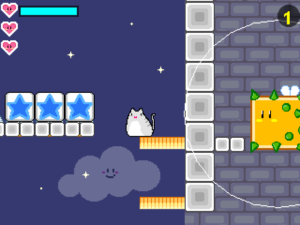
The goal of each stage is usually to find one or more valuable objects and touch them to send them crashing to the ground with an over-the-top explosion. The number of objects to destroy is always listed in the upper-right corner unless there is a special objective for the stage and the objects themselves become increasingly more ridiculous as the game goes on, starting with unassuming coffee mugs and vases and ramping up to include treasure chests and various priceless artifacts. Controls are very solid, but they may take a few stages to master. Lavi immediately turns into a rolling ball when moving on the ground and this ability is something of a double-edged sword as it lets her move quickly at the cost of creating some momentum which can make it tricky to move with perfect precision. Lavi can also cling to and jump off of paw blocks on the walls, but her most important move is the ability to transform into a rocket while in the air. You can perform this rocket transformation at any point when Lavi is not touching the ground by holding the jump button and any of the four cardinal directions. Though Lavi can only move in one direction at a time as a rocket, you will often need to move around corners by cancelling the transformation and quickly launching in a new direction, especially in the second half of the game. It’s also not possible to rely on the rocket ability to cruise through the levels because the fuel meter drains in about a second and only refills once Lavi is back on the ground (or whenever you cancel out of the rocket form while underwater).
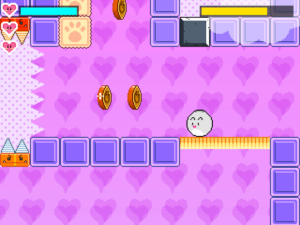
Every one of the 18 stages can be finished within a minute or two, but nearly all of them contain unique elements or new combinations of old mechanics. Many of the stages are nonlinear and present multiple routes or spread breakable objects out in different directions. Lavi only starts each stage with two health, but more health can be found scattered throughout every stage (though Lavi can’t have more than four at a time), and she has infinite lives. Even with its generous health refills and cartoonish style, Lavi Quest can become remarkably brutal at times and there is a very noticeable jump in difficulty and stage complexity after the halfway point so you can definitely expect to rack up a few deaths before the end of this quest. Some enemies can be defeated just by touching them, but most hazards simply need to be avoided. Several of these foes are particularly devious because they can follow Lavi for long distances, such as enormous square bumblebees which will lazily fly towards Lavi if she is within a circular perimeter around them and underwater jellyfish which can be nearly impossible to shake unless you find a spot to leave the water and reenter from far away.
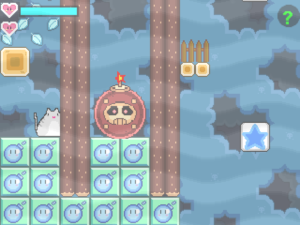
As to the stage mechanics themselves, many of them are unique enough to remain memorable long after finishing the game. On the more simple side of things you have stages such as a forest where leaves in the foreground make it more difficult to spot objects and enemies and a cave where you must jump over mines on conveyor belts while avoiding flying ghosts which don’t deal damage and instead momentarily stun Lavi, putting her in danger of being pushed into a mine or a pit by a conveyor belt. As far as more creative stages go, two stages involve walking across ‘sad’ blocks to make them happy while being careful to avoid turning them back into being sad by stepping on them a second time, another stage requires you to push large bombs across gaps and through the air to destroy bomb blocks, yet another stage replaces the destructible item counter with a meter which gradually depletes as you destroy dozens of large coins, and at one point you even dodge waves of enemies while flying through space as a perpetual rocket. My favorite stage is a very orange one where you need to avoid several round enemies while making your way to a key at the end and then make your way back to the unlocked area near the start. The trick to this particular stage is that it is also filled with stationary plusses which increase the size of the enemies when collected; there is a substantial shortcut near the start of the stage and a very useful health pickup along the way, but both of these require you to touch several plusses and it becomes a balancing act between taking risks to keep the enemies small or taking safer routes which may lead to the enemies becoming too big to avoid by the end. Stages with entirely unique mechanics are spread out well and even the more standard stages often alternate between open stages with several scattered objects and more linear challenges with one or two objects at the end.
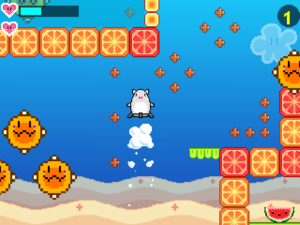
One final, yet very important, piece of praise I need to give to Lavi Quest is for just how well it teaches players about each of its mechanics without any sort of dialogue or blatant tutorials beyond a minimalistic, largely pictorial screen at the start to explain the controls and the objective. The first two stages are even shorter than usual and don’t contain any hazards; the first stage familiarizes you with rolling, rocket jumping, and knocking over an object while the second stage introduces you to wall jumping, blocks which crack when you step on top of them and then break when you move off of them, and the fact that you may need to find and destroy multiple objects to complete a stage. It’s not just the basics which Lavi Quest is good at teaching though. The first stage to contain water starts with an open and almost entirely safe area to experiment in, the orange stage has a clump of plusses and some out-of-the-way enemies at the start to show you that enemies grow when you touch plusses, the bomb stage starts with a bomb on the other side of a wall of bomb blocks to safely show you that bombs create dangerous bullets when they explode and can destroy entire groups of these blocks if they detonate while touching them, and so on. The entire game serves as a great example of how to quickly and efficiently show players how to interact with new mechanics and obstacles without excessive handholding and without ripping away control to tell them with tedious tutorials.
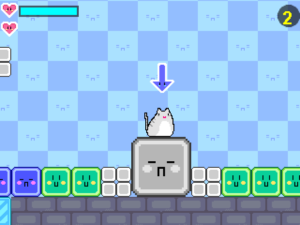
As much as I may wish that Lavi Quest had at least a few more stages, it packs enough challenge and variety into its short length to leave you satisfied by the end and there is a high degree of polish across the board. If you ever thought it would be cool to save the day by knocking objecting onto the ground, now is your chance to make it happen!